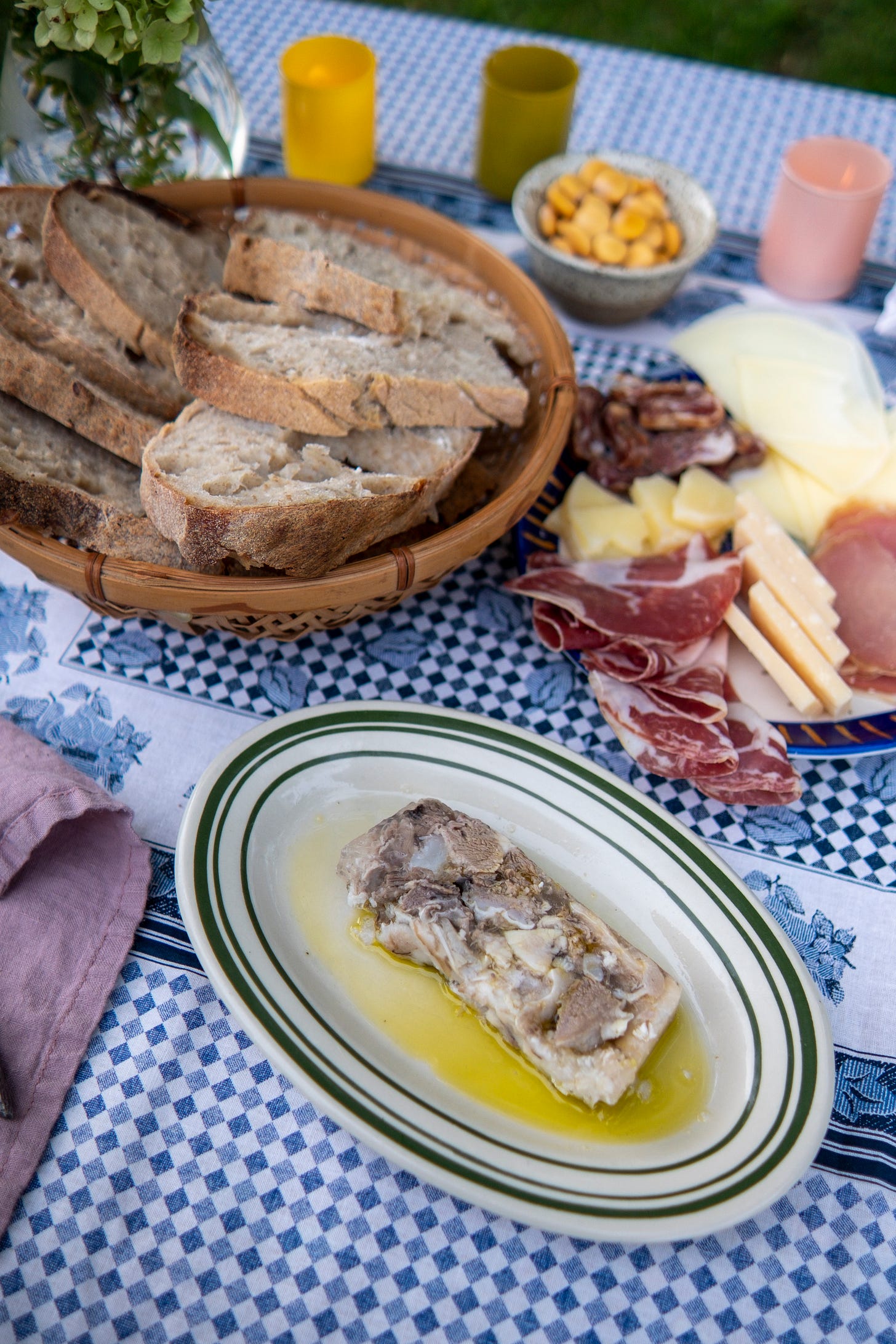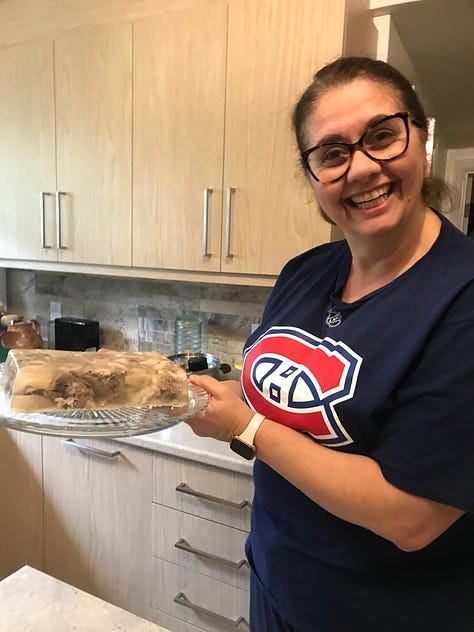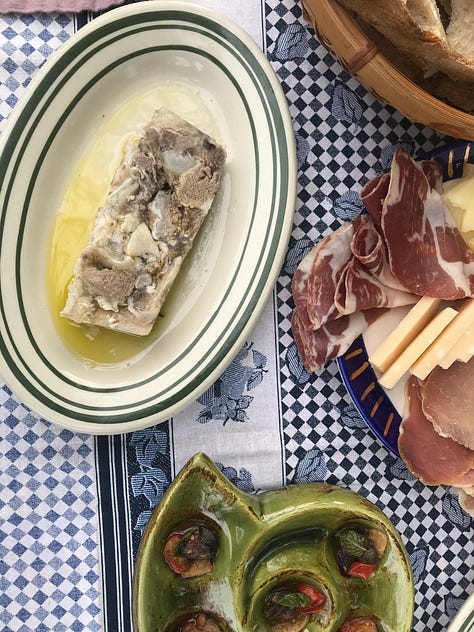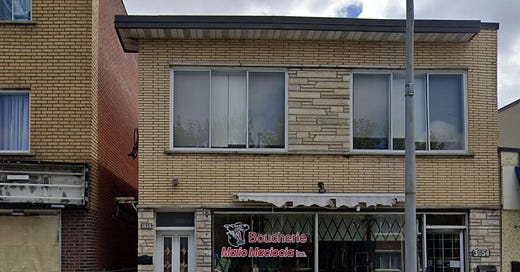I’ve been thinking about the family business my maternal great-grandparents established when they immigrated to Montreal: Boucherie Mario Maciocia. I have plans to ask my nonna and her two brothers if I can interview them about the butcher shop to have a record of those early years. I know how important it is to archive the histories of these family businesses, as, currently, they are not well documented in the historical record.
I’ve had it on my mind because I wrote about it in a piece that was submitted - and accepted!! - to kitchen work, for their next issue called “Cities.” In the piece, I write about food in Saint-Leonard, the east-end Montreal neighbourhood where I grew up. Particularly, it focused on the businesses on and around Jean-Talon street near my parents’ when I was younger. Though the family butcher shop was established around 1961 on Bélair street, by 1964, they had moved to their new location on Jean-Talon.
When I interviewed her for the cookbook, my nonna explained: "Nella mia famiglia, sopratutto erano macellai e commercianti di animali. E dopo hanno continuato qui in Canada. Siamo immigrati nel 1959 e papà e i miei fratelli hanno continuato l'attività che avevano in Italia."1 And the last couple of times I went to Molise, I spent a lot of time with my nonna’s childhood best friend and next door neighbours. They told me countless stories of my great-grandfather and his business, transporting and selling animals at different markets across the southern Italian regions. Though I can’t remember the context, my paternal nonno Sam recently explained that we are from a “meat family,” on my mom’s side. When we make sausages, we always bug my mom with this because she has a knack for handling the casing that the rest of us don’t. “Well, it’s in your blood,” we say.
All these things are at the back of my mind lately, as I remind myself to ask about this interview: I want to know more about the butcher shop and what it was like to run this business in 1960s Saint-Leonard. And when I think about this, I also think about the special experience I shared with my mom two years ago: making gelatina.

Basically Molisan head cheese, gelatina was one of the recipes my nonna submitted to the cookbook. It’s a way to make use of every part of the pig after it had been slaughtered, as it’s made with the head2 and feet. As you can imagine, it’s not something we typically make today. But I decided to take on the challenge to test the recipe and get some photos for the book. We ordered a head and feet from our trusted butcher.
I’ll spare you the worst of the process pictures, but if you’re squeamish, maybe skip to “Digging Deeper.”
I remember my nonna explaining the process to me: before boiling, you have to
remove the jowls and brain
cut the head into pieces; clean the ears, tongue and everything else thoroughly
pay particular attention to the bristles of hair, pass over a flame to remove if necessary
do the same for the feet
Of course, today, if you order a pig’s head from the butcher, they will cut it in half for you, should you need. It arrives clean and ready for you to use. We just had to do step one and then cut. I say “just” as if it was easy… it was not. Upon seeing the size of the head and realizing the task at hand, I knew I wouldn’t be able to do it alone and I immediately recruited my mom. We were both a little grossed out at first, but she was really the perfect person to do it with me: we took over my nonna’s kitchen and got to work, documenting the process, pleasantly surprised when we started to get the hang of it. I couldn’t imagine what it must have been like doing this from scratch, from the whole pig.


By the time we finished, everything looked as it should and all we could do was wait for the next day, to see if the gelatin would solidify. We had just recreated a traditional dish that would have been made the day the family pig was butchered. Everything possible would have been prepared, cured, cooked. Even the blood would have been used to make jelly (farrucc’) or pudding (sanguinaccio). The only thing discarded from our gelatina were the eyes, brain, and the bones, stripped of their meat.
Digging Deeper
As we were making the gelatina, I saw genuine pride in my mom’s face. Pride in herself and in us. We were sending pictures to everyone; she called her zio down the street, who told us to bring some over when it was ready. When he tried it, he said we could make it again. I don’t think we ever will, but I’ll take the compliment! My nonna was in Italy at the time, so we had to wait for her to come back for final and absolute approval. We served it as one of the appetizers for her first family meal back (though not everyone wanted to try it). Spread on a piece of toasted bread, she also let us know that we did a great job.



This experience is one of the gifts the cookbook project gave me. It’s not something I would have ever done without the need to test the recipe. Hearing how excited my great-uncle was to try our version of a favourite recipe he hadn’t had in ages; seeing my mom beaming, as we knew we were both doing something that directly connected us to her father and so many of our ancestors before; feeling that “meat family” heritage in my blood. It was special.
“Who would have imagined that a third-generation Italian would be making gelatina at home?” my mom said, smiling, after we finished the recipe. Neither of us did, that’s for sure.
Do you connect to ancestral family trades/talents? How?
Have you had a special experience cooking or preparing food with a family member? What did you prepare?
What recipes from your culture aren’t made as much today, if at all?
Cass
“In my family, mostly they were butchers and animal traders. And after that they continued here in Canada. We immigrated in 1959, and my dad and my brothers continued the business they had in Italy.”
Guanciali - jowls - should be removed, as this is then cured and shouldn’t go to waste in the jelly.






